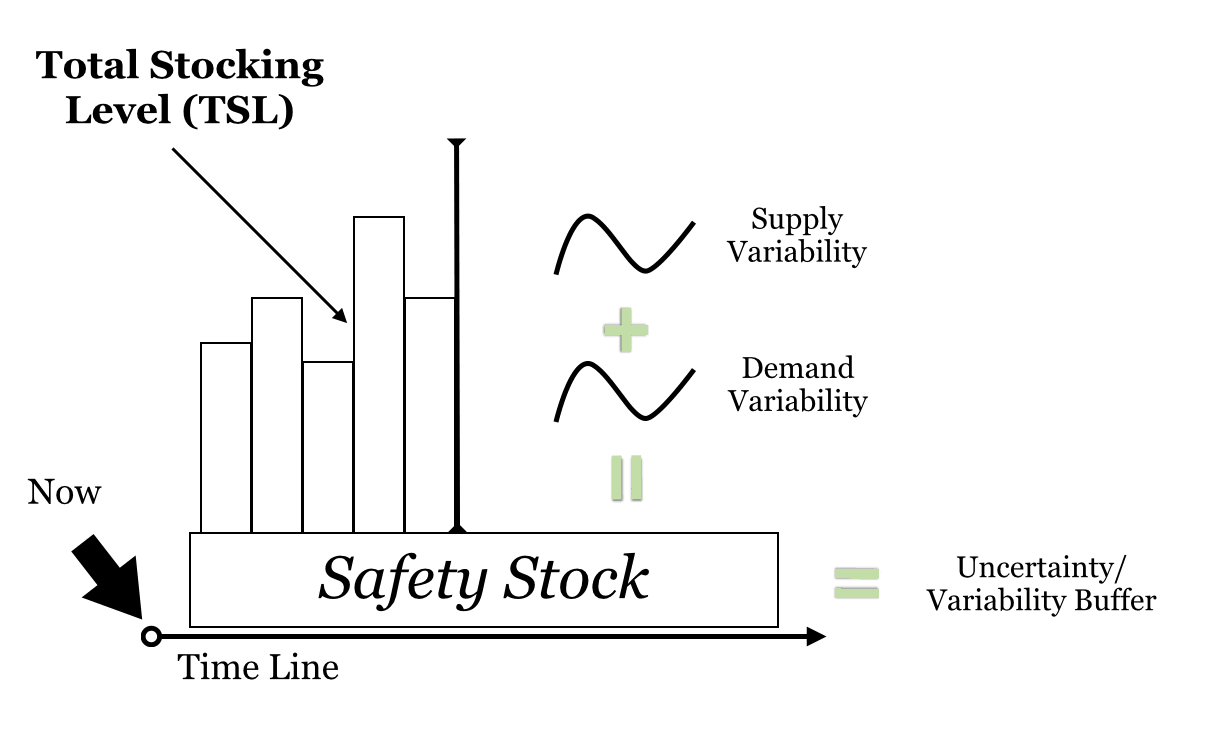How to Use the Brightwork Internet Based Dynamic Safety Stock Calculation
Executive Summary
- This article introduces the dynamic safety stock calculation and reviews the current safety stock calculation explanations.
- There is a general preference for talking about the standard dynamic safety stock calculation rather than diving into its math.

Introduction to Calculating Safety Stock
This dynamic safety stock calculation article has two purposes:
- To calculate safety stock.
- To explain the logic behind the mathematics or the safety stock equation of the dynamic safety stock calculator.
See our references for this article and related articles at this link.
Reviewing the Current Safety Stock Calculation Explanations
Before writing this article and creating this calculator, I reviewed quite a few of the available safety stock calculation spreadsheets available from the Internet. I found all to be deficient in not fully explaining the formula.
- Almost every one of them asked for a service level input. They did not even explain what the definition of the service level calculation definition to be used.
- The vast majority ignored the lead time component of the formula. They only provided input for sales/forecast variability (error).
This is not a good way to explain how dynamic safety stock works. Those that left out part of safety stock calculation formulas or safety stock equation did not even explain that it was left out — giving any person who is trying to understand the entire formula a difficult time! How can one know the right to calculate safety stock without showing those assumptions?
The Preference for Talking About the Dynamic Safety Stock Rather than Diving into the Math
It seems as if many people want to talk about dynamic safety stock. No one was interested in making a precise calculator that explains calculating safety stock in clear terms.
There is a broader problem with the formula in that most of the explanations of the formula are not specific enough as to what the author is referring to.
- For instance, what is “Average Demand.” Without knowing the duration, this does not mean very much of anything.
- Is this the average over lead time, or the monthly average, the yearly average?
This safety stock calculator provides intermediate values. It also provides explanations so that the overall logic of the dynamic safety stock calculator can be understood by both students and practitioners.
Basic Concept of Dynamic Safety Stock
The basic concept of the dynamic safety stock calculation is to adjust the safety stock per multiple factors.
Often the explanation of dynamic safety stock is that it is to adjust for both supply and demand variability — as is expressed in the graphic below:

The Uses of Dynamic Safety Stock
The beautiful thing about the dynamic safety stock calculation or safety stock equation is that it adjusts across the following dimensions:
- Service level
- Lead time
- Forecast error both in variability (regarding lead time and forecast error) as well as lead time duration.
Dynamic safety stock analysis can be used for an SKU or any aggregation level. For instance, this form can be used to model the inventory and supply chain of an entire company.
That is, instead of entering the values for a single SKU, the average values can be used. This helps one see the relationships between things like service level and the total amount of stock carried.
This can create a service level for the inventory curve. This is something that many companies do not have. It will not, of course, include the total stocking level. So the overall stocking level should be estimated and added. Only the safety stock should flex — while the cycle stock should stay the same.
Using Dynamic Safety Stock in Production Systems
While dynamic safety stock is quite valuable for analysis, one of the problems with dynamic safety stock is that it will often calculate a value that companies consider too high. Typically companies will not hold this level of safety stock, as is explained in this article. This is because the standard dynamic safety stock formula in textbooks does not work, and consistently overestimates the safety stock required.
What This Calculation Is
- The standard dynamic safety stock calculator is problematic in actual usage. For this reason, I created this safety stock calculator, which adopts some of the same concepts but provides more consistent output.
- Currently, the calculator does not include lead time variability. In most cases, the vast majority of variability is from the demand rather than the lead time side.
How the Brightwork Safety Stock Calculation Form Works
This safety stock calculation is not the standard dynamic safety stock. It is instead of our own customized dynamic safety stock.
This form requires input to provide output. However, it also has default values. You can change any input value and the rest of the formula — the output will change immediately. You can continue making changes, and the form will always update without having to press any button or refresh. This will accurately support you in calculating safety stock.
Note: For some reason, the drop-down field below does not appear to work in Firefox – so if you are using that browser, try a different one. Second, when you enter a decimal into the Standard Deviation of Demand and Standard Deviation of Lead Time, you may receive a message “Please enter only digits.” You can ignore that message. The calculator works fine with a decimal point.
For the reverse safety stock calculator sees this link.